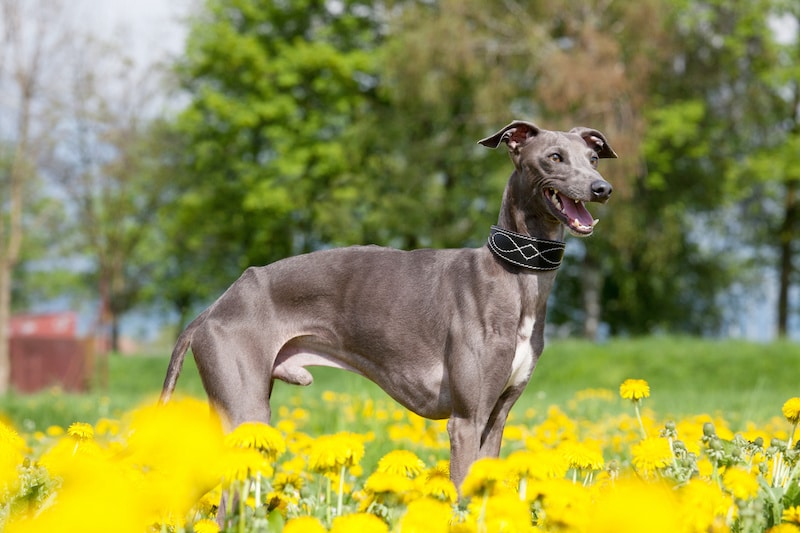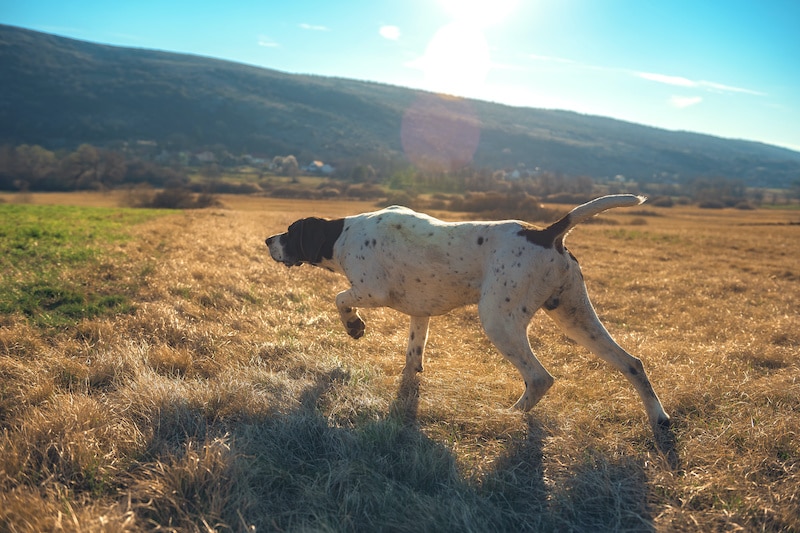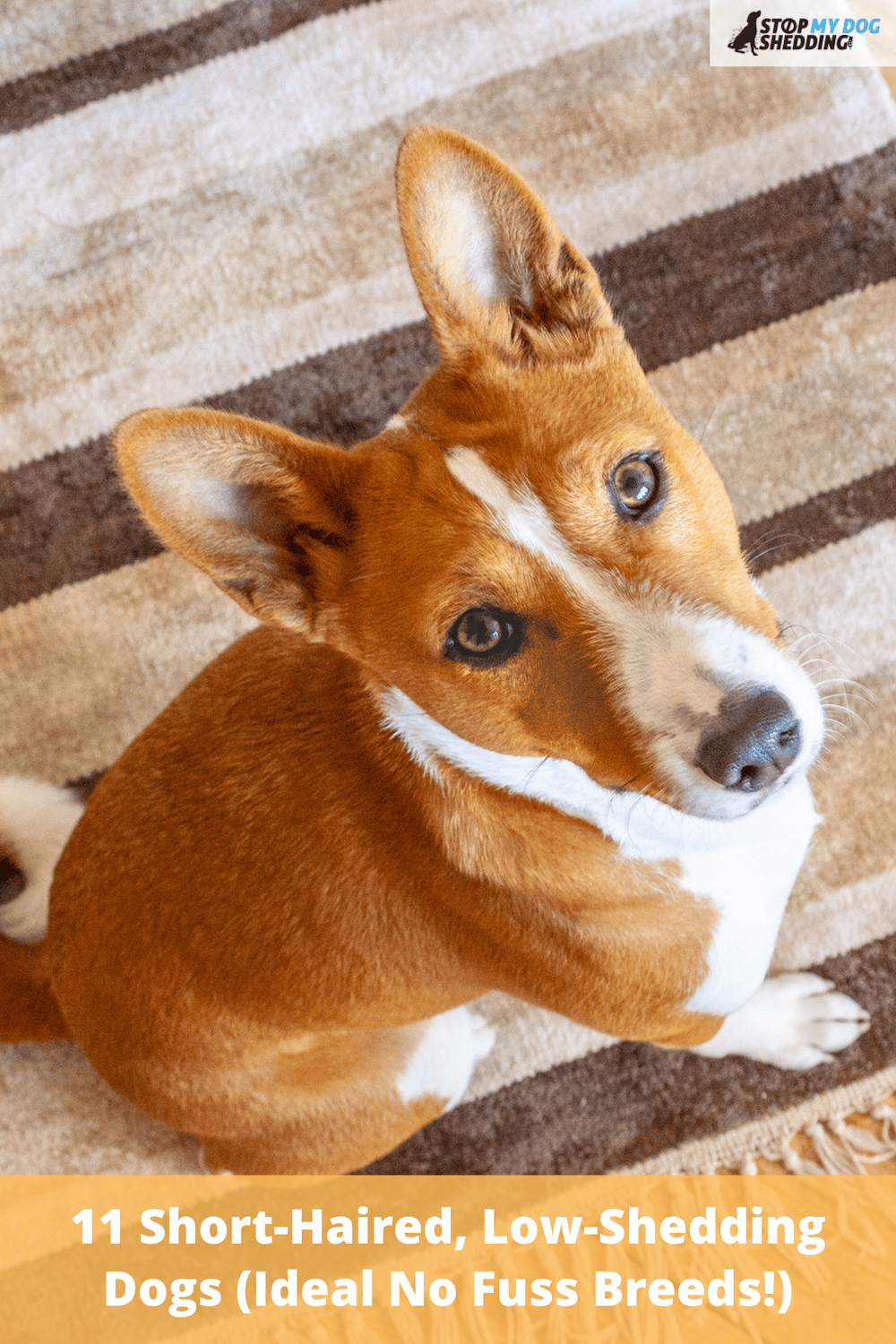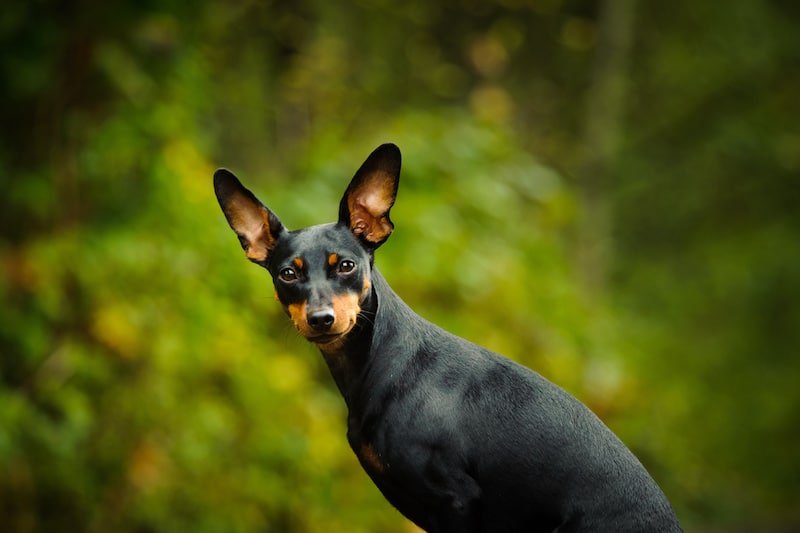If you’ve always wanted a dog with an easy maintenance coat due to its short fur and one that’s very low shedding, this list is exactly what you’ve been looking for.
In this post, I’ll show you some of the best low-shedding, easy-to-groom breeds and give you a breakdown of each breed’s traits, shedding, and grooming needs to help you compare.
Here’s the list:
1. Redbone Coonhound
2. American Staffordshire Terrier
3. Vizsla
4. Miniature Pinscher
5. Cane Corso
6. Boston Terrier
7. Italian Greyhound
8. Whippet
9. Basenji
10. Rhodesian Ridgeback
11. German Shorthaired Pointer
These 11 dogs prove that you can enjoy an easy, breezy maintenance routine and not have to clean up much fur. Keep reading for more information about these incredible breeds!
1. Redbone Coonhound

- Shedding Level: 2/5 (low)
- Grooming Effort: 1/5 (very low)
Starting the list is the Redbone Coonhound, a Coonhound breed from the southern United States that’s quite an adept hunter (this dog can hunt bears and cougars!).
Like many Coonhounds, the Redbone has exceptionally close-cropped fur, so you can easily take in this dog’s awe-inspiring musculature.
Coonhound shedding depends a lot on the breed. In the case of the Redbone, his short fur sheds so little because it’s coarse and single-layered.
You don’t have to worry about increases in seasonal shedding from this mid-sized dog, either! With a grooming mitt you use about once a week, you can keep your Redbone Coonhound’s colorful coat glossy, shiny, healthy, and low-shedding!
2. American Staffordshire Terrier

- Shedding Level: 1/5 (very low)
- Grooming Effort: 1/5 (very low)
The American Staffordshire Terrier is a Pit Bull breed. If you can get past that, then you’ll find a dog who checks all the boxes you’re looking for.
AmStaffs have very short coats. Like the Redbone Coonhound, this allows you to witness the way an AmStaff’s muscles ripple when he runs or catches a toy. American Staffordshire Terriers are quite buff, especially compared to Coonhounds!
The reason this Pit Bull breed is so low-shedding is quite similar to the Redbone. AmStaffs feature single-layered wiry coats.
Now, the AmStaff’s fur is a little stiffer, so I’d recommend a bristle brush as opposed to a grooming mitt.
Even still, you can brush your pup as seldomly as once weekly without having to worry about your home becoming a fur pit.
3. Vizsla

- Shedding Level: 2/5 (low)
- Grooming Effort: 1/5 (very low)
Of course, you would expect to see a breed like the Vizsla on this list.
The dog known as the Hungarian Pointer is a mid-sized hunting dog with only one fur layer. The fur grows just inches long but doesn’t shed to excess if your Vizsla is healthy.
I should note that double-coated Vizslas do exist and are usually available through specialty breeders. However, the consensus is that this version of the Vizsla does not match the breed standards.
Still, if yours is a double-coated Vizsla, you can bet you’ll see an uptick in shedding at times. The dog will shed seasonally in both the winter and the summer.
Getting back to the regular Vizslas that meet breed standards, keeping them groomed is exceptionally simple. You can brush your dog once per week using a rubber brush or a bristle brush.
Since the Vizsla has such a close-cut coat, the weekly brushing sessions will feel like a nice massage for your pup!
Recommended: Go here to see our top-rated dog hair blow dryers
4. Miniature Pinscher

- Shedding Level: 2/5 (low)
- Grooming Effort: 1/5 (very low)
How about a smaller dog for a change of pace? The Miniature Pinscher is indeed as small as its name would allude, weighing no more than 11 pounds and standing at about 12 inches tall max.
Min Pins, compared to other small breeds, aren’t the lowest-shedding, but they are far from the highest-shedding.
The American Kennel Club doesn’t recognize the Min Pin as hypoallergenic either, but that’s okay.
Grooming this dog is so fast and easy that you might never want to own another breed again. Use a bristle brush or a rubber brush for weekly Min Pin brushing.
If your Min Pin is shedding more than you’d like, then increase its rate of brushing to twice per week. There shouldn’t ever be a need for daily or near-daily brushing, though!
5. Cane Corso

- Shedding Level: 2/5 (low)
- Grooming Effort: 1/5 (very low)
On the complete opposite end of the size spectrum is the Cane Corso, a ginormous dog from Italy that’s been used for all sorts of purposes, including guarding and hunting.
Large dogs typically shed heaps, but the Cane Corso proves that doesn’t have to be true.
That said, since the Cane Corso is double-coated, prepare yourself (and your home) for several weeks of seasonal shedding both in the winter and then in the summer.
Due to the large dog’s short fur, the shedding uptick isn’t too egregious.
Keeping a Cane Corso well-groomed entails brushing the dog at least weekly using a rubber brush or a bristle brush.
You might want to increase the rate of brushing to almost daily (if not every single day) during those seasonal shedding bouts.
You’ll collect all the dead fur before it can be shed from your dog, which will make your home a lot cleaner!
Recommended: Go here to see our top-rated dog hair blow dryers
6. Boston Terrier

- Shedding Level: 2/5 (low)
- Grooming Effort: 1/5 (very low)
Here’s another dog from the US, the classic Boston Terrier.
The Boston Terrier is a small companion animal with a lively, spunky personality. His short coat makes his bat ears and bug eyes that much more noticeable!
That same coat isn’t susceptible to much shedding except when the seasons begin to change. That’s right; just as is the case with the Cane Corso, the Boston Terrier sheds seasonally.
You know what I’m about to say then. You’ll want to increase the rate of brushing to contend with the uptick in shedding.
For the rest of the year, you can very easily brush your Boston Terrier weekly, and its fur won’t take over your home and your wardrobe.
The smoothness and shortness of a Boston Terrier’s coat make brushing this dog a delight!
7. Italian Greyhound

- Shedding Level: 2/5 (low)
- Grooming Effort: 1/5 (very low)
Most Greyhounds do shed quite a bit, but the Italian Greyhound or Iggy is not like most Greyhounds.
For starters, the Iggy is the smallest of the Greyhounds. It’s the dog’s size that contributes to its low shedding propensity. The less surface area a dog has, after all, the less fur it tends to release.
Italian Greyhounds are single-coated as well, so you don’t have to stress about the dreaded seasonal shedding periods.
Regarded as semi-hypoallergenic (although not considered hypoallergenic in the AKC’s book), the Iggy makes for a fantastic companion animal.
You’ll appreciate how easy it is to keep this small but appealing dog groomed, as you only have to dig out your soft bristle brush or rubber mitt once a week.
8. Whippet

- Shedding Level: 2/5 (low)
- Grooming Effort: 1/5 (very low)
Could the Whippet be just the dog you’ve been looking for? Perhaps!
Although, as a relative of the Greyhound, you might worry the Whippet would be a moderate shedder, it’s not. The tall, stately, slim breed is quite low-shedding indeed.
Whippets are single-coated but do shed seasonally. This is an uncommon occurrence but can happen in some single-coated breeds, so the Whippet is by no means an anomaly.
The rate of shedding shouldn’t be as intense as a double-coated dog, so at least you can take solace in that.
As was the case with the Italian Greyhound, grooming your Whippet with a rubber hand mitt or a bristle brush once a week is sufficient for keeping this dog’s coat gleaming beautifully and shedding less.
9. Basenji

- Shedding Level: 2/5 (low)
- Grooming Effort: 1/5 (very low)
The small, quiet dog with the forehead wrinkles known as the Basenji is another great breed to add to this list.
The dog’s single coat is very close-cropped from the head to the tail. Basenjis aren’t particularly muscular, but you can appreciate the dog’s bat-like ears as well as the aforementioned forehead wrinkles better, thanks to the fur length.
For the most part, the Basenji doesn’t shed much.
This is another breed that will blow its coat twice per year despite only having a single layer of fur. The rate of cleanup over those periods is more than usual but not terrible.
Here’s a fun fact about the Basenji: this canine has some cat-like qualities, preferring to groom itself so you can keep bath time to a minimum.
You will have to groom this unique dog, which you can do with a bristle brush. Weekly brushing does the trick during most of the year. And you can ramp up the rate of brushing to every day or every other day when the Basenji blows its coat.
10. Rhodesian Ridgeback

- Shedding Level: 2/5 (low)
- Grooming Effort: 1/5 (very low)
Besides the telltale ridge of hair down its back that grows in a reverse pattern than the rest of its coat, the Rhodesian Ridgeback is a very short-haired and thus low-shedding dog.
That’s a good thing, as the Rhodesian Ridgeback is no small four-legged friend. The dog stands nearly 30 inches tall and weighs 90 pounds!
You don’t have to worry about seasonal shedding with a Rhodesian Ridgeback, which is definitely a huge plus.
To groom your Ridgeback, a rubber or bristle brush is a good tool to use. You can brush the dog about weekly to maintain that glossy sheen.
11. German Shorthaired Pointer

- Shedding Level: 2/5 (low)
- Grooming Effort: 1/5 (very low)
Last but certainly not least is the German Shorthaired Pointer, a European pointing dog that’s also a surprisingly adept hunter.
The GSP’s coat is coarse and short. It’s also double-layered and rather thick, so expect your canine companion to blow its coat ahead of the winter and the summer.
I’d recommend a daily brushing routine for the GSP. You can use a hand mitt, a bristle brush, or even a fine-tooth comb.
Just make sure you’re combing through both layers of the dog’s fur to pull out the loose, dead hair before it sheds!
Bottom Line
If you’re looking for short-haired dogs that don’t shed much, the 11 breeds I’ve discussed are the perfect companions. The short fur of each dog makes its shedding manageable even during seasonal shedding spikes.
Of course, just because a dog should be low-shedding doesn’t exclusively mean that’s true as it does depend on the individual dog. And there are other factors that contribute to shedding, such as your dog’s diet, overall health, and the time of year.
Grooming your dog regularly is a great means of controlling how much fur it loses, but there’s more too you can do to manage the shedding.
For instance, it’s always worth keeping your dog on a healthy, well-balanced diet full of nutrients, minerals, and vitamins. Try to keep the fillers to a minimum, especially since those types of ingredients can cause allergies in some canines.
You can also bathe your dog no more frequently than necessary, and be sure to use dog-friendly shampoo to prevent dry, itchy skin.
And if you’re concerned the shedding isn’t normal, it may be worth taking your dog to the vet for a checkup. Also, we’ve created a complete guide to managing shedding that you may find helpful, so be sure to check that out if you want to know more.













Please note: By submitting a comment using the above comment form, you confirm that you agree with the storage and handling of your data by this site as detailed in our Privacy Policy.